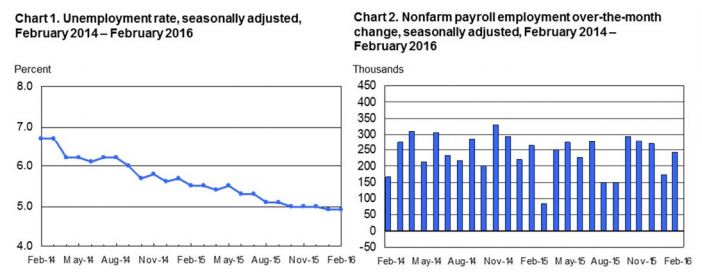 The much-anticipated February 2016 Employment Summary from the Bureau of Labor Statistics (BLS) released on Friday showed a mixed bag in the U.S. labor market. While February’s job gains were solid at 242,000 and the labor force participation rate shot up to a 15-month high, a noticeable weakness in the labor market is wage growth.
The much-anticipated February 2016 Employment Summary from the Bureau of Labor Statistics (BLS) released on Friday showed a mixed bag in the U.S. labor market. While February’s job gains were solid at 242,000 and the labor force participation rate shot up to a 15-month high, a noticeable weakness in the labor market is wage growth.
Amid all the positives in the February employment summary, however, the average hourly earnings for all employees declined by 3 cents down to $25.35 after an increase of 12 cents in January. The average workweek also declined in February by 0.2 hours down to approximately 34.4 hours. The lack of wage growth combined with house price appreciation has caused some concenrs as far as affordability in the housing market, according to Fannie Mae chief economist Doug Duncan.
“On the housing front, builders continue to hire more workers, but at a steadily slowing pace since last November, suggesting little relief to one factor underlying extremely tight inventories,” Duncan said. “Our forecast of a more modest gain in home sales this year reflects our concern of declining housing affordability from income growth that is trailing home price appreciation. Today’s jobs report is consistent with our view of an affordability-constrained housing expansion.”
“Our forecast of a more modest gain in home sales this year reflects our concern of declining housing affordability from income growth that is trailing home price appreciation.”
Fannie Mae Chief Economist Doug Duncan
The labor force participation rate, which last year plummeted to its lowest level since the 1970s, climbed to 62.9 percent in February from January’s rate of 62.7 percent with the addition of about 555,000 to the workforce over-the-month. In the last three months, approximately 1.5 million people have been added to the labor force. Also, the employment-to-population ratio jumped up to 59.8 percent, its highest level since April 2009. The unemployment rate remained unchanged over-the-month in February at 4.9 percent, its lowest level in eight years.
February’s job additions (242,000) were well above the market expectations of 190,000. February's gains combined with upward revisions to the December and January figures (to 271,000 and 152,000, respectively), compute to an average monthly job gain of 228,000 over the three month period from December, January, and February.
 “The February jobs report, which shows strong payroll gains and upward revisions to the prior two months, is in line with recent improving economic data and financial market conditions and should continue to calm recession fears,” Duncan said. “Another point in the positive column is the third consecutive rise in the labor force participation rate—a welcome trend unseen since late 2006. In the negative column, average hourly earnings and the average workweek each pulled back following encouraging improvements in the prior month.”
“The February jobs report, which shows strong payroll gains and upward revisions to the prior two months, is in line with recent improving economic data and financial market conditions and should continue to calm recession fears,” Duncan said. “Another point in the positive column is the third consecutive rise in the labor force participation rate—a welcome trend unseen since late 2006. In the negative column, average hourly earnings and the average workweek each pulled back following encouraging improvements in the prior month.”
The positives contained in the employment summary for February has analysts predicting that the Fed is on track to raise short-term interest rates in the summer.
“This was a mixed report with positives in the overall jobs figure for February, upward revisions to prior months, and another strong month for labor force entrants,” said NAFCU chief economist Curt Long. “The participation rate climbed again and is up one-half percentage point since September. But the wage figure was disappointing, particularly coming after a strong month in January. With that said, once inflation is considered, 2.2 percent wage growth is not terrible, and as the labor market continues to tighten we should see that figure climb. As for the Fed, this was a decent report but not one that would hold anybody’s feet to the fire to raise rates later this month. We expect the Fed to hold in March with an eye toward a rate hike in June.”
More charts and analysis on the February nonfarm payroll employment numbers https://t.co/g1NChl6Lxc #JobsReport #BLSdata
— BLS-Labor Statistics (@BLS_gov) March 4, 2016
Paul Ashworth, chief U.S. economist for Capital Economics, said, “Overall, it’s clear that labor market conditions are still strong. The lack of a more marked pick-up in wage growth is the only missing element. But as far as the Fed is concerned, it is already seeing a clear acceleration in core price inflation, so it can’t delay raising interest rates for much longer. A June rate hike is coming.”
Realtor.com chief economist Jonathan Smoke said he believes the February employment summary bodes well for the homebuying market this spring.
“February’s employment situation report should strengthen consumer confidence. Additionally, the strong pace of job creation should lead to continued positive household formation,” Smoke said. “Combined with substantial pent-up demand for home purchases, we remain confident we will see the strongest spring buying season in a decade.”
Click here to see the entire February 2016 Employment Summary from the BLS.

 theMReport.com Your trusted source for mortgage banking news
theMReport.com Your trusted source for mortgage banking news








